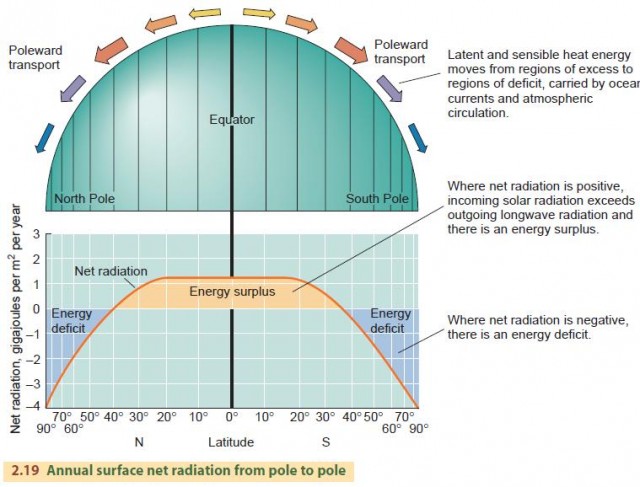Net Radiation, Latitude, and the Energy Balance
Although the energy budgets of the Earth's surface and atmosphere are in balance overall, their budgets do not have to balance at each particular place on the Earth, nor do they have to balance at all times. At night, for example, there is no incoming radiation from the Sun, yet the Earth's surface and atmosphere still emit out going radiation. Net radiation is the difference between all incoming radiation and all outgoing radiation. In places where radiant energy flows in faster than it flows out, net radiation is positive, providing an energy surplus. In other places, net radiation can be negative. For the entire Earth and atmosphere, the net radiation is zero over a year.
We saw earlier that solar energy input varies strongly with latitude. What is the effect of this variation on net radiation? To answer this question, let's look at Figure 2.19, which shows the net radiation profile from pole to pole. Between about 40° N and 40° S there is a net radiant energy gain, labeled “energy surplus.” In other words, incoming solar radiation exceeds outgoing longwave radiation throughout the year. Poleward of 40° N and 40° S, the net radiation is negative and is labeled “energy deficit”—meaning that outgoing longwave radiation exceeds incoming shortwave radiation. If you examine the graph carefully, you will find that the area labeled “surplus” is equal in size to the combined areas labeled “deficit.” So the net radiation for the Earth's surface as a whole is zero, as expected, with global incoming shortwave radiation exactly balancing global outgoing longwave radiation.

Because there is an energy surplus at low latitudes and an energy deficit at high latitudes, energy will flow from low latitudes to high. This energy is transferred poleward as latent and sensible heat—warm ocean water and warm, moist air move poleward, while cooler water and cooler, drier air move toward the Equator.
We'll return to these flows in later chapters. But keep in mind that this poleward heat transfer, driven by the imbalance in net radiation between low and high latitudes, is the power source for broad-scale atmospheric circulation patterns and ocean currents. Without this circulation, low latitudes would heat up and high latitudes would cool down until a radiative balance was achieved, leaving the Earth with much more extreme temperature contrasts—very different from the planet that we are familiar with now.